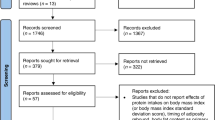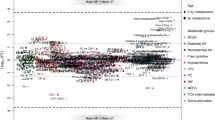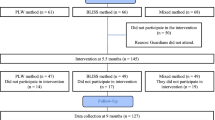Abstract
Background/Objectives:
High protein intake in infancy affects future obesity risk and other health outcomes. We aim to describe total protein intake and its sources in a birth cohort in five European countries over the first 2 years of life.
Subjects/Methods:
A total of 746 formula-fed infants were included. Three-day weighed dietary records at 6, 7, 8, 9, 12, 18 and 24 months of age were used. Kruskal–Wallis, ANOVA and Friedman’s tests were used to assess possible differences in nutritional intake among countries and over time.
Results:
Dairy products were the main components of the infants’ diets. Cow’s milk was rarely introduced before 12 months of age, whereas infants’ formula was the main contributor of protein intake. Food choices and protein intake differed among countries (P<0.001). Protein intake often exceeded European recommendations from 9 months onwards, partly because of the substitution of dairy protein (mainly infant formula) by meat protein. Two nutritional patterns were identified that were characterised by differences in energy, fat, protein and animal protein intake. Finally, food consumption was not always in line with protein intakes, and thus infants from some countries showed high consumption of specific food groups but relatively low protein intakes.
Conclusions:
During weaning, over-limited substitution of dairy products with other sources (especially meat) resulted in relatively high protein intakes in formula-fed infants. Differences in preferences of specific protein sources from complementary foods existed among European countries. Great opportunities in improving early nutrition were revealed, although cultural and geographical differences should always be considered.
This is a preview of subscription content, access via your institution
Access options
Subscribe to this journal
Receive 12 print issues and online access
$259.00 per year
only $21.58 per issue
Buy this article
- Purchase on Springer Link
- Instant access to full article PDF
Prices may be subject to local taxes which are calculated during checkout



Similar content being viewed by others
References
Pedersen AN, Kondrup J, Borsheim E . Health effects of protein intake in healthy adults: a systematic literature review. Food Nutr Res 2013; 57: 1–29.
Pedersen AN, Cederholm T . Health effects of protein intake in healthy elderly populations: a systematic literature review. Food Nutr Res 2014; 58: 1–39.
Hornell A, Lagstrom H, Lande B, Thorsdottir I . Protein intake from 0 to 18 years of age and its relation to health: a systematic literature review for the 5th Nordic Nutrition Recommendations. Food Nutr Res 2013; 57: 1–42.
Koletzko B, von Kries R, Closa R, Escribano J, Scaglioni S, Giovannini M et al. Lower protein in infant formula is associated with lower weight up to age 2 y: a randomized clinical trial. Am J Clin Nutr 2009; 89: 1836–1845.
Socha P, Grote V, Gruszfeld D, Janas R, Demmelmair H, Closa-Monasterolo R et al. Milk protein intake, the metabolic-endocrine response, and growth in infancy: data from a randomized clinical trial. Am J Clin Nutr 2011; 94 (6 suppl), 1776S–1784S.
Rzehak P, Grote V, Lattka E, Weber M, Gruszfeld D, Socha P et al. Associations of IGF-1 gene variants and milk protein intake with IGF-I concentrations in infants at age 6months - Results from a randomized clinical trial. Growth Horm IGF Res 2013; 23: 149–158.
Rzehak P, Sausenthaler S, Koletzko S, Reinhardt D, von Berg A, Kramer U et al. Short- and long-term effects of feeding hydrolyzed protein infant formulas on growth at<or=6 y of age: results from the German Infant Nutritional Intervention Study. Am J Clin Nutr 2009; 89: 1846–1856.
Devaney B, Ziegler P, Pac S, Karwe V, Barr SI . Nutrient intakes of infants and toddlers. J Am Diet Assoc 2004; 104 (1 Suppl), s14–s21.
Fox MK, Reidy K, Novak T, Ziegler P . Sources of energy and nutrients in the diets of infants and toddlers. J Am Diet Assoc 2006; 106 (1 Suppl 1), S28–S42.
Grimes CA, Szymlek-Gay EA, Campbell KJ, Nicklas TA . Food sources of total energy and nutrients among U.S. infants and toddlers: National Health and Nutrition Examination Survey 2005-2012. Nutrients 2015; 7: 6797–6836.
Wang H, Denney L, Zheng Y, Vinyes-Pares G, Reidy K, Wang P et al. Food sources of energy and nutrients in the diets of infants and toddlers in urban areas of China, based on one 24- hour dietary recall. BMC Nutr 2015; 1: 1–15.
Schiess S, Grote V, Scaglioni S, Luque V, Martin F, Stolarczyk A et al. Introduction of complementary feeding in 5 European countries. J Pediatr Gastroenterol Nutr 2010; 50: 92–98.
Grote V, Schiess SA, Closa-Monasterolo R, Escribano J, Giovannini M . Scaglioni S, et al. The introduction of solid food and growth in the first 2 y of life in formula-fed children: analysis of data from a European cohort study. Am J Clin Nutr 2011; 94 (6 Suppl), 1785S–1793S.
Luque V, Escribano J, Mendez-Riera G, Schiess S, Koletzko B, Verduci E et al. Methodological approaches for dietary intake assessment in formula-fed infants. J Pediatr Gastroenterol Nutr 2013; 56: 320–327.
Dehne LI, Klemm C, Henseler G, Hermann-Kunz E . The German Food Code and Nutrient Data Base (BLS II.2). Eur J Epidemiol 1999; 15: 355–359.
Verwied-Jorky S, Schiess S, Luque V, Grote V, Scaglioni S, Vecchi F et al. Methodology for longitudinal assessment of nutrient intake and dietary habits in early childhood in a transnational multicenter study. J Pediatr Gastroenterol Nutr 2011; 52: 96–102.
Commission Directive 96/5/EC, Euratom on processed cereal-based foods and baby foods for infants and young children. CELEX-EUR Official Journal L 49, 1996, pp 17–28.
Agostoni C, Scaglioni S, Ghisleni D, Verduci E, Giovannini M, Riva E . How much protein is safe? Int J Obes (Lond) 2005; 29 (Suppl 2), S8–S13.
Alles MS, Eussen SR, van der Beek EM . Nutritional challenges and opportunities during the weaning period and in young childhood. Ann Nutr Metab 2014; 64: 284–293.
Michaelsen KF, Hoppe C, Lauritzen L, Molgaard C . Whole cow's milk: why, what and when? Nestle Nutr Workshop Ser Pediatr Program 2007; 60: 201–216; discussion 16-19.
Agostoni C, Decsi T, Fewtrell M, Goulet O, Kolacek S, Koletzko B et al. Complementary feeding: a commentary by the ESPGHAN Committee on Nutrition. J Pediatr Gastroenterol Nutr 2008; 46: 99–110.
Gidding SS, Dennison BA, Birch LL, Daniels SR, Gillman MW, Lichtenstein AH et al. Dietary recommendations for children and adolescents: a guide for practitioners: consensus statement from the American Heart Association. Circulation 2005; 112: 2061–2075.
Rolland-Cachera MF, Bellisle F, Deheeger M . Nutritional status and food intake in adolescents living in Western Europe. Eur J Clin Nutr 2000; 54 (Suppl 1), S41–S46.
Lambert J, Agostoni C, Elmadfa I, Hulshof K, Krause E, Livingstone B et al. Dietary intake and nutritional status of children and adolescents in Europe. Br J Nutr 2004; 92 (Suppl 2), S147–S211.
Cruz JA . Dietary habits and nutritional status in adolescents over Europe—Southern Europe. Eur J Clin Nutr 2000; 54 (Suppl 1), S29–S35.
Parizkova J . Dietary habits and nutritional status in adolescents in Central and Eastern Europe. Eur J Clin Nutr 2000; 54 (Suppl 1), S36–S40.
Yngve A, Wolf A, Poortvliet E, Elmadfa I, Brug J, Ehrenblad B et al. Fruit and vegetable intake in a sample of 11-year-old children in 9 European countries: The Pro Children Cross-sectional Survey. Ann Nutr Metab 2005; 49: 236–245.
Mennella JA, Ziegler P, Briefel R, Novak T . Feeding Infants and Toddlers Study: the types of foods fed to Hispanic infants and toddlers. J Am Diet Assoc 2006; 106 (1 Suppl 1), S96–106.
Butte N, Cobb K, Dwyer J, Graney L, Heird W, Rickard K et al. The Start Healthy Feeding Guidelines for Infants and Toddlers. J Am Diet Assoc 2004; 104: 442–454.
FAOSTAT FAO Statistics Division 2015, Available at http://faostat.fao.org/site/368/default.aspx#ancor accessed 27 January 2015.
Halkjaer J, Olsen A, Bjerregaard LJ, Deharveng G, Tjonneland A, Welch AA et al. Intake of total, animal and plant proteins, and their food sources in 10 countries in the European Prospective Investigation into Cancer and Nutrition. Eur J Clin Nutr 2009; 63 (Suppl 4), S16–S36.
Acknowledgements
The studies reported herein have been carried out with partial financial support from the Commission of the European Community, specific RTD Programme ‘Quality of Life and Management of Living Resources’, within the 5th Framework Programme, research grants no. QLRT–2001–00389 and QLK1-CT-2002-30582, and the 6th Framework Programme, contract no. 007036 and the European Union's Seventh Framework Programme (FP7/2007-2013), project EarlyNutrition under grant agreement n°289346. This manuscript does not necessarily reflect the views of the Commission and in no way anticipates the future policy in this area. The formula for the study was produced by Bledina (Villefranche-sur-Saône Cédex, France, part of Danone Baby Nutrition), who operated as a partner of this EU project and received a grant from the EU Commission for this task. No funding bodies had any role in study design, data collection and analysis, decision to publish or preparation of the manuscript. This study was also supported by the Child Health Foundation (Munich, Germany).
Author information
Authors and Affiliations
Corresponding author
Ethics declarations
Competing interests
The authors declare no conflict of interest.
Rights and permissions
About this article
Cite this article
Damianidi, L., Gruszfeld, D., Verduci, E. et al. Protein intakes and their nutritional sources during the first 2 years of life: secondary data evaluation from the European Childhood Obesity Project. Eur J Clin Nutr 70, 1291–1297 (2016). https://doi.org/10.1038/ejcn.2016.108
Received:
Revised:
Accepted:
Published:
Issue Date:
DOI: https://doi.org/10.1038/ejcn.2016.108



